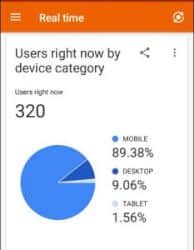Google Analytics is the Best and Most Complete Way to Monitor your Blog Traffic. However, Many New bloggers find it difficult to Setup Google Analytics. They prefer to Use Jetpack and Other Statistics Plugins.
To ensure you don’t have any issue, I have explained how to set up Google analytics on your blog within 15 Minutes. You can check it out here or continue reading for important terms you will come across in Google Analytics and what they mean.
Terms Used In Google Analytics
The top terms in Google Analytics Are:
- Real-Time
- Active Users
- Page Views
- Unique Visitors
- Direct Traffic
- Organic Traffic
- Behavior
- Audience
- Acquisition
- Bounce Rate
Real Time: Shows the Visitors that are on your site right now. Real time changes frequently because visitors join and leave your site frequently.
Active Users: This refers to the number of users on your blog over a given period of time. One Day Active Users are the users who visited your site during the last day, 7 Day Active Users are the users who visited your site during the last seven days, etc.
Pageviews: This refers to the number of pages being viewed on your blog. If your daily pageviews is 10,000, it means 10,000 pages are being viewed daily on your blog. Visitors refer to the number of persons visiting your blog.
Recommended: Meaning of searchingdog in Google Analytics
Unique Visitors: a person who visits your blog at least once within a specified period. It is the average number of visits per unique visitor in the given time frame. This is calculated by dividing the number of total visits by the number of unique visitors.
Direct Traffic: Most often the result of a user entering a URL into their browser or using a bookmark to directly access your blog. Essentially, Direct sessions occur any time Google Analytics cannot determine another referring source or channel.
Organic Traffic: Visitors who are considered organic find your website after using a search engine like Google or Bing, so they are not “referred” by any other website.
Direct traffic can include visits that result from typing the URL directly into a browser, as the simple definition suggests. Organic traffic, on the other hand, are those visits which are tracked by another entity ”” usually because they have arrived through search engines but also from other sources.
Bounce Rate: It’s the percentage of visitors who land on a single page but fail to explore any additional content on your site. They just enter and they exit.
Acquisition: This includes the age of your visitors, their gender and interests. You can also get data about where your viewers are coming from, whether from Facebook, other websites, or Google search.
Behavior: “User behavior” data include how long a user stayed on your website, what is their first and last page on your website and the most common “pathway” through which they go through your website.
In other words, behavior flow marks the path visitors take and shows which pages they’re looking after arriving on the initial landing page.
Audience: Users that you group together based on any combination of attributes that is meaningful to your business.
Hope you learnt something new? Feel free to share this article with your friends and do not fail to drop your comment.

Leave a Reply